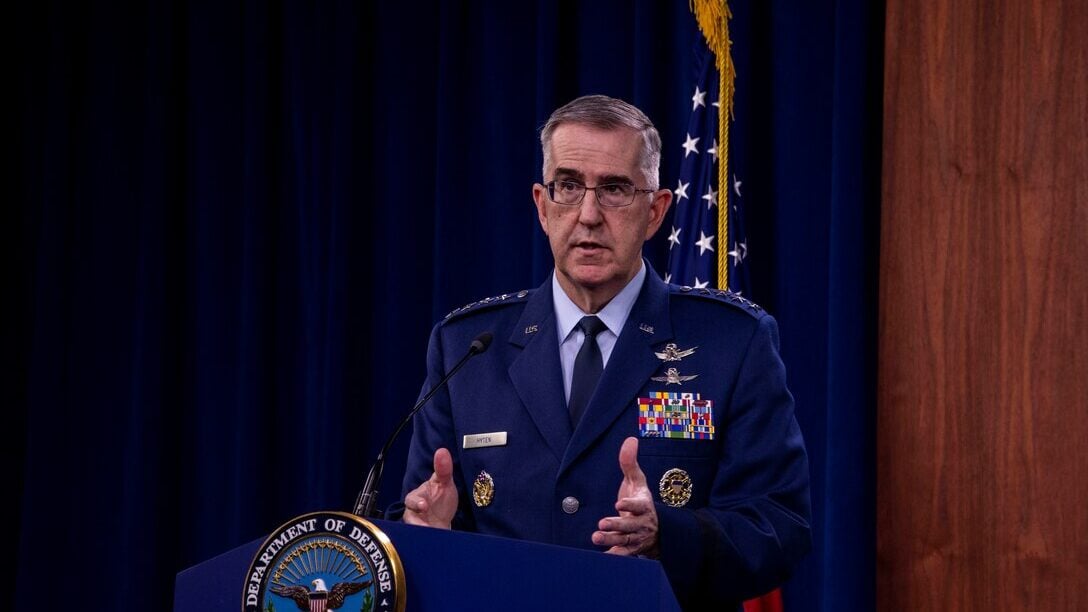
Gen. John Hyten (File)
WASHINGTON: In what may be his valedictory remarks as vice chairman of the Joint Chiefs of Staff, Gen. John Hyten continued his quest to prod the Pentagon acquisition elephant to move faster. One telling example: China, he said, has performed “hundreds” of tests of hypersonic weapons in the last five years, compared to nine the United States has performed.
How did it come to this? Hyten pointed to a a painting, located on the fourth floor of the Pentagon, to illustrate how things have changed for the US military since the days of the space race.
“So I like rockets, but it’s just a rocket taking off, and it’s a little rocket. And there’s actually nothing else in the picture except the rocket taking off, but there’s the little label on the bottom. It says, Discover 14. And why that’s so cool to me, is that Discover One through 13 failed.” Discover 14, in fact, carried America’s first spy satellite, one of the Corona series, into orbit.
“We launched one through 13 and they failed in like 18 months because our approach at the time was to test and instrument the heck out of it, fail, learn what failed, build another one, fire, learn what failed. Build another one, fire it, learn what failed. If you want to go fast,” he said. “That’s what you do.”
That fear of failure that now dominates the US military is not holding back competitors like China — or, in what may be a surprising example, North Korea.
“As opposed to his father and his grandfather, [Kim Jong Un] decided not to kill the scientists and engineers when they failed. He decided to encourage and let them learn by failing and they did,” Hyten said. “And so the 118th biggest economy in the world — 118th! — has built an ICBM nuclear capability because they test and they understand risk.”
But for the Pentagon, there are myriad obstacles in the way of such an approach these days. There’s the bureaucracy. There’s Congress. And, Hyten said, of course there’s the media.
“So now, whatever you’re testing, whether it’s a missile, an airplane, missile defense system, if it fails, you guys put it on the front page of every newspaper in the world, in the country, that says, ‘missile defense test fails.’ There’s one test that we actually meant to fail because we were trying to drive it to failure. And the headline still said, ‘missile defense test fails,’ and there’s hearings and everything that we go through and we stopped for two years.”
Hyten pointed to hypersonic technology as the “perfect example” of America’s acquisition problems.
“We were developing hypersonics ahead of everybody in the world and the first test failed. The first test of everything fails. So the first test fails, and we have two years of investigation into why did it fail,” he said. “Two years, and we launched again, and it fails. So, we cancel the program. We stop and then others start building hypersonics. They start doing it the way we used to do it and they start moving fast. And so we start the programs again.”
He pointed to the latest hypersonic test where some technology failed. “But now we’re going to study that to death before we move on again. We have to understand risk and development. Technology is hard,” he said.
China’s Hypersonic Weapons
Hyten implied this morning, but did not state categorically, that China has built and tested what appears to be a Fractional Orbital Bombardment System (FOBS).
FOBS technology is not new, but Hyten described it “as highly destabilizing.” And China’s reported use of a nuclear-capable hypersonic glide vehicle (HGV) as the pointy end of the stick would be a twist. The Soviets deployed a FOBS — which combines a low-flying missile and nuclear warhead that reaches Low Earth Orbit, but does not remain in space for a full turn about the Earth — from 1969 to 1983. China began an effort in the early 1970s, but suffered test failures with its launcher, and gave up. They appear to have resumed the effort and succeeded.
RELATED: Hypersonic Space Test Fuels Sino-American Arms Race
On the issue of China, which Hyten noted does not pose the imminent existential threat to the United States that Russia does because of its huge nuclear arsenal, the outgoing vice chairman said recent evidence from western China of new ICBM fields shows “every indication” that China is abandoning its longstanding policy of minimum deterrence.
“You don’t need to develop the kind of capabilities they’re developing for a minimum deterrence. The work they’re doing on hypersonics, the work to fill out the triad, the work to build both a fixed-base ICBM program and a mobile ICBM program at the same time, to put ballistic missiles on bombers, to put ballistic missiles on submarines — you know, when you look at that structure, that is not a minimum deterrence model,” Hyten said.
RELATED: China’s Nuclear Forces Swell: A Tri-Polar World?
He brushed aside any commitments by any country to a so-called “no first use” policy.
“What I worry about is capability. And if you’re a military officer, you have to worry about the capability and the possibility that an adversary will use that capability against you,” he said. “And so you have to assume that capability is meant for a reason and plan for that. So, you know, the political side has to worry about the words. The military side, we have to focus on that capability.”
In the only breaking news of the day, Hyten said he was “probably” going to approve “today or tomorrow a new requirement for Integrated Air and Missile Defense.” This is a pillar of the Joint Warfighting Concept (JWC), which is central to All Domain Operations.
The first four strategic directives, issued in June, defined joint requirements for Joint All Domain Command and Control (JADC2), joint fires, contested logistics and information dominance.
The IAMD requirement arose from a capability gap review specifically aimed at informing the Missile Defense Review, a major policy document that both assesses America’s missile defense posture and provides guidance on future investments.
The Missile Defense Review and the Nuclear Posture Review will be integrated as part of the National Defense Strategy, due in January.






















